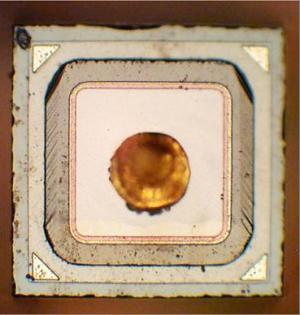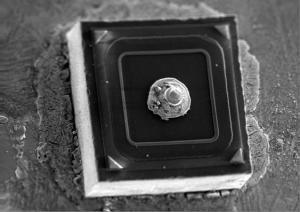BZT52B5V6-V Diode Failures
Gideon Analytical Laboratories performed failure analysis on several BZT52B5V6-V Zener diodes with dead shorts. The most common function of a diode is to allow an electric current to pass in one direction (forward direction) while blocking current in the opposite direction (reverse direction). Thus, the diode can be viewed as an electronic version of a check valve with current passing in only one direction and blocked in the opposite direction. This unidirectional behavior is called rectification and allows one to convert alternating current to direct current.
These diodes are ROHS, 5.6V and 12V with 2% voltage tolerance, with 500 mW power dissipation. The diodes had some conformal coating, which was removed to expose the marking code to identify this diode as part of the Vishay semiconductor. All five diode were electrically tested and found to be dead short.
Several of the diodes were decapsulated to expose the diode. Upon visual inspection of the die, the abnormality was not distinguishable and the recessed area under the ball bond could not be discerned. In none of these diodes are there any visible defects (as revealed in the picture at top left). There are no holes due to spikes in the p-region, no manufacturing defects on the sides of the die, Kerf, or any cracks. There was also no evidence of overheating. Later in the analysis, a voltage spike was found under the gold ball bond.
SEM-EDS analysis revealed the die being just silicon, as it should be. A micrograph of the die is pictured at the top right. Both 5.6V and 12V diodes were tested electrically with a curve tracer to ensure the operation.
In the case of these diodes, the failures have no physical indication they are failures. The electrical data confirms they are dead short. Because the failures are sometime in the field, these would be considered reliability failures. This is reflective of either an inherent manufacturing flaw associated with the construction of this device, or some unknown usage phenomena-taking place in the field, or some environmental issues exacerbating a weakness in the diode construction. The SEM-EDS analysis produced no contamination on the die surface that would cause the die to short. Chemically speaking the die was clean. A voltage spike under the gold wire bond was the cause of the short.
Failure analysis performed by Gideon Analytical Laboratories not only identifies causes of failures but at times identifies the phenomenon are not the causes of failures. Knowing whether a failure’s origin is in production or in a field application is exceedingly important information to know. This information can save companies in the electronics industry an enormous amount of time and money.

Nomarski picture of the diode after decapsulating

Diode Micrograph from Scanning electron microscope